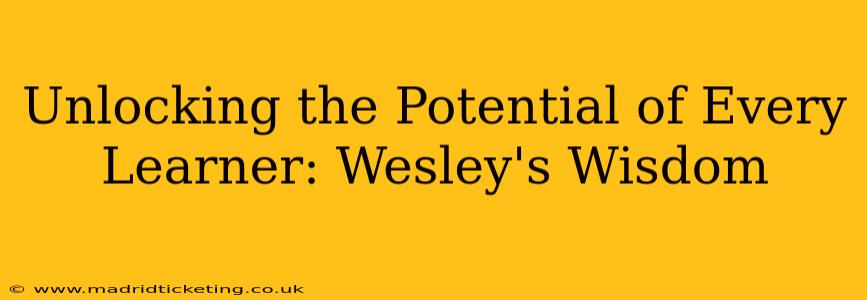Educators and parents alike constantly search for effective strategies to nurture and unlock the potential within each learner. This quest for optimal learning environments and methodologies is ongoing, and finding the right approach for every individual child presents a unique challenge. This article delves into the principles and practices that contribute to maximizing each student's potential, drawing inspiration from a hypothetical educator we'll call Wesley, whose wisdom embodies effective teaching practices.
What Makes a Great Teacher?
Wesley believes that a truly great teacher isn't defined by a specific teaching style or curriculum, but rather by a deep understanding of individual learning styles and an unwavering commitment to student growth. This involves recognizing that every student is unique, possessing different strengths, weaknesses, learning preferences, and emotional needs. Wesley's approach emphasizes personalized learning, adapting teaching methods to cater to the diverse needs of his students. He understands that a "one-size-fits-all" approach is ineffective in fostering true potential.
How Can I Help My Child Learn Better?
Many parents wonder how they can best support their child's learning journey at home. Wesley advises parents to become active participants in their child's education, fostering a positive and supportive learning environment at home. This includes:
- Open communication: Regularly discussing schoolwork, challenges, and successes with your child.
- Creating a dedicated study space: Ensuring a quiet and organized area for homework and studying.
- Encouraging a growth mindset: Emphasizing effort and progress over grades, fostering resilience and a love of learning.
- Engaging in learning activities together: Reading together, playing educational games, and exploring educational resources as a family.
What are Different Learning Styles?
Understanding different learning styles is key to unlocking a student's potential. Wesley identifies several key learning styles:
- Visual Learners: These students learn best through seeing, using diagrams, charts, videos, and other visual aids.
- Auditory Learners: These students learn best through hearing, benefiting from lectures, discussions, and audio recordings.
- Kinesthetic Learners: These students learn best through hands-on activities, experiments, and physical movement.
- Reading/Writing Learners: These students learn best through reading and writing, benefiting from textbooks, notes, and essays.
Wesley emphasizes that many students are a blend of these styles, and tailoring instruction to accommodate these diverse learning preferences is vital.
How Can I Identify My Child's Learning Style?
Identifying your child's learning style requires observation and engagement. Wesley suggests:
- Observing your child's study habits: Do they prefer visual aids, or do they prefer to listen to lectures? Do they benefit from hands-on activities?
- Asking your child about their preferences: Directly ask your child how they prefer to learn.
- Working with teachers: Collaborate with your child's teachers to gain insights into their learning styles and preferences.
What are Some Strategies for Personalized Learning?
Wesley champions personalized learning, tailoring instruction to individual student needs. Some effective strategies include:
- Differentiated instruction: Modifying assignments and activities to meet individual learning needs and abilities.
- Flexible grouping: Using various grouping strategies (individual, small group, whole class) based on student needs and learning objectives.
- Technology integration: Using educational technology to personalize learning experiences and provide targeted support.
- Project-based learning: Engaging students in in-depth projects that allow them to explore their interests and develop critical thinking skills.
By implementing these strategies, Wesley creates a dynamic and engaging learning environment where every student feels valued, supported, and empowered to reach their full potential.
Conclusion: Nurturing Potential
Unlocking every learner's potential requires a multifaceted approach, emphasizing individual needs, personalized learning strategies, and a collaborative effort between educators, parents, and students. By embracing Wesley's wisdom—a blend of understanding, adaptability, and a deep commitment to student growth—we can create truly effective learning environments where every student thrives.

